Devil’s Canyon Review: Intel Core i7-4790K and i5-4690K
by Ian Cutress on July 11, 2014 10:00 AM EST- Posted in
- CPUs
- Intel
- Haswell
- i7
- Overclocking
- Devil's Canyon
- i5
- 4790K
- 4690K
CPU Benchmarks
The dynamics of CPU Turbo modes, both Intel and AMD, can cause concern during environments with a variable threaded workload. There is also an added issue of the motherboard remaining consistent, depending on how the motherboard manufacturer wants to add in their own boosting technologies over the ones that Intel would prefer they used. In order to remain consistent, we implement a OS-level unique high performance mode on all the CPUs we test which should override any motherboard manufacturer performance mode.
HandBrake, SD Film: link
For HandBrake, we take two videos (a 2h20 640x266 DVD rip and a 10min double UHD 3840x4320 animation short) and convert them to x264 format in an MP4 container. Results are given in terms of the frames per second processed, and HandBrake uses as many threads as possible.
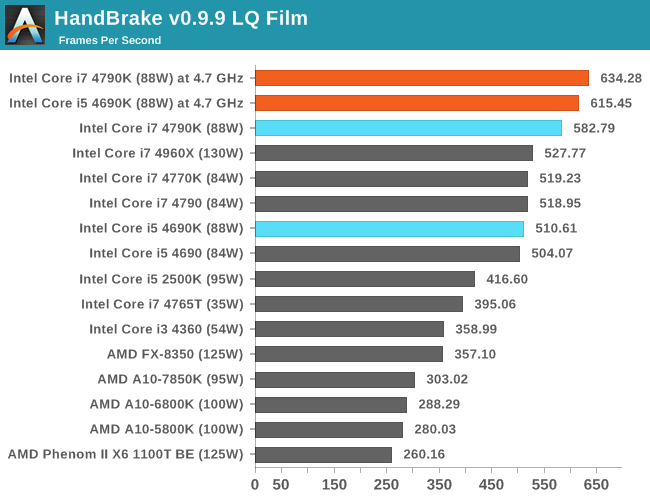
HandBrake, 4K60 Animation: link
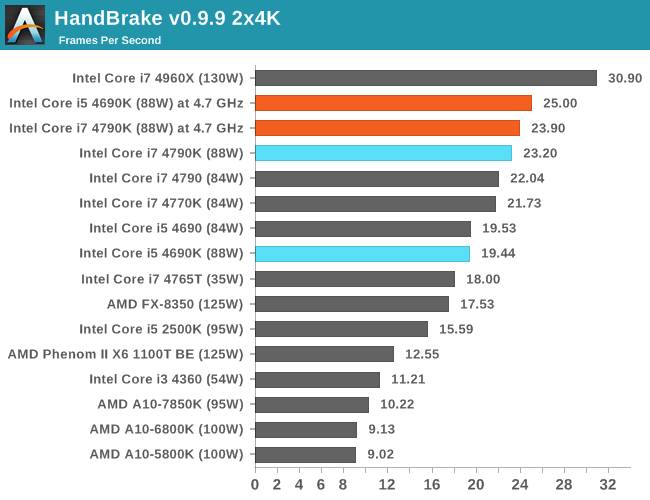
Agisoft Photoscan – 2D to 3D Image Manipulation: link
Agisoft Photoscan creates 3D models from 2D images, a process which is very computationally expensive. The algorithm is split into four distinct phases, and different phases of the model reconstruction require either fast memory, fast IPC, more cores, or even OpenCL compute devices to hand. Agisoft supplied us with a special version of the software to script the process, where we take 50 images of a stately home and convert it into a medium quality model. This benchmark typically takes around 15-20 minutes on a high end PC on the CPU alone, with GPUs reducing the time.
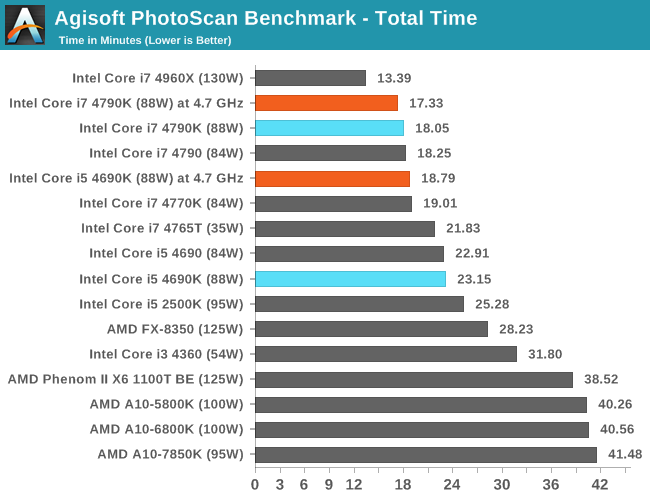
Dolphin Benchmark: link
Many emulators are often bound by single thread CPU performance, and general reports tended to suggest that Haswell provided a significant boost to emulator performance. This benchmark runs a Wii program that raytraces a complex 3D scene inside the Dolphin Wii emulator. Performance on this benchmark is a good proxy of the speed of Dolphin CPU emulation, which is an intensive single core task using most aspects of a CPU. Results are given in minutes, where the Wii itself scores 17.53 minutes.
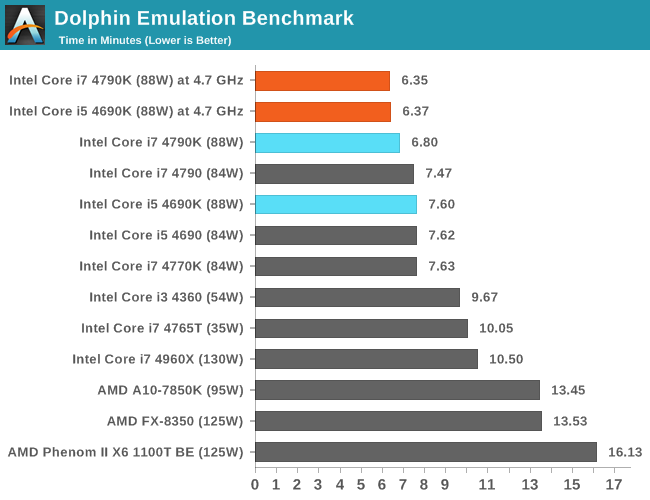
WinRAR 5.0.1: link
This test compresses a set of 2867 files across 320 folders totaling 1.52 GB in size – 95% of these files are small typical website files, and the rest (90% of the size) are small 30 second 720p videos.
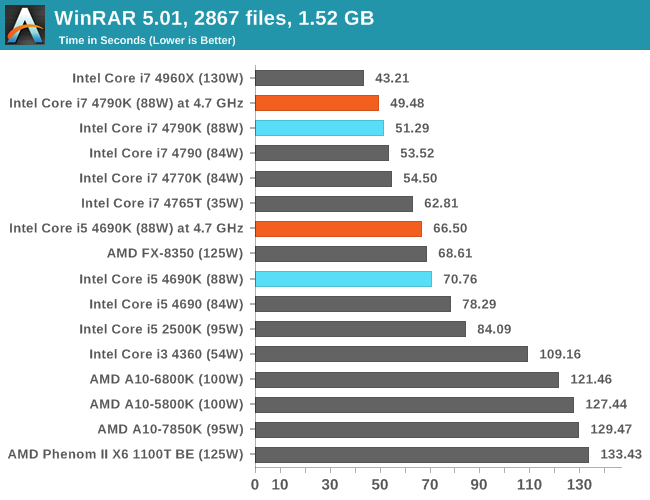
PCMark8 v2 Work 2.0 OpenCL on IGP
A new addition to our CPU testing suite is PCMark8 v2, where we test the Work 2.0 and Creative 3.0 suites in OpenCL mode. As this test is new, we have not run it on many AMD systems yet and will do so as soon as we can.
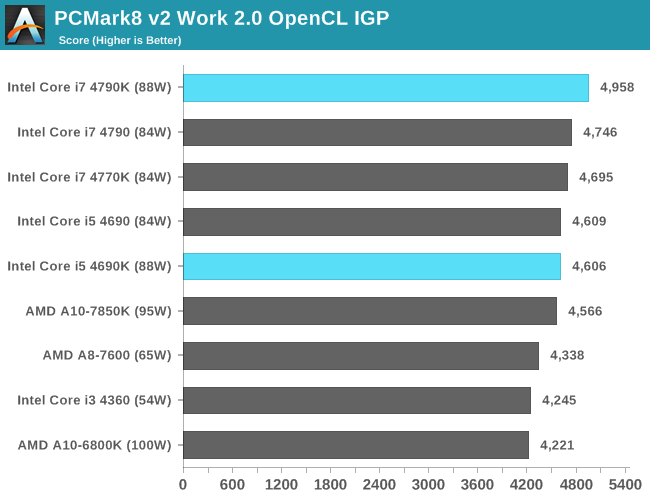
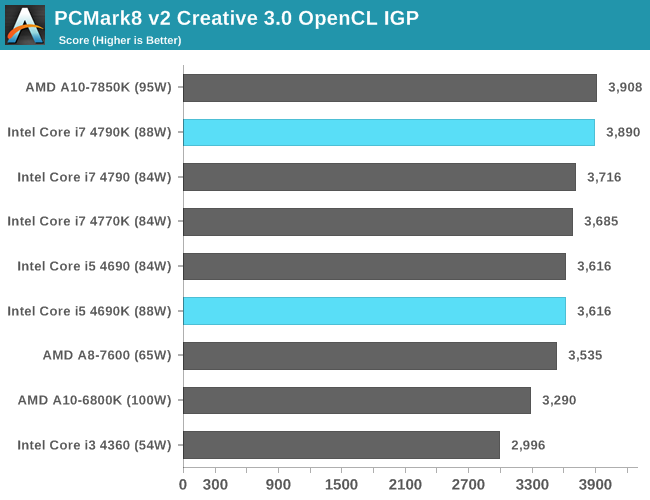
Hybrid x265
Hybrid is a new benchmark, where we take a 4K 1500 frame video and convert it into an x265 format without audio. Results are given in frames per second.
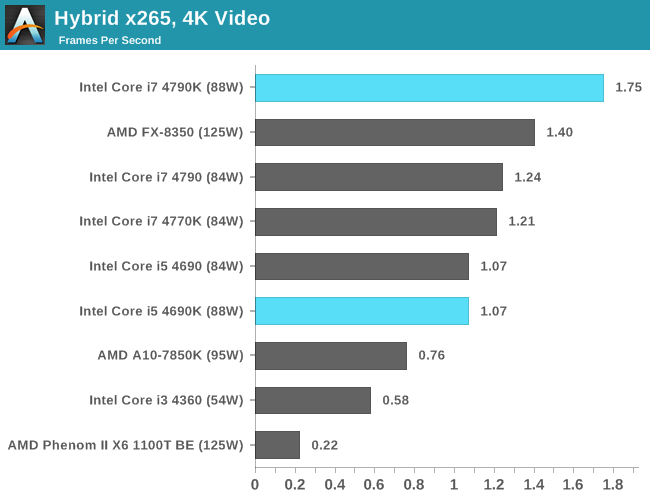
Cinebench R15
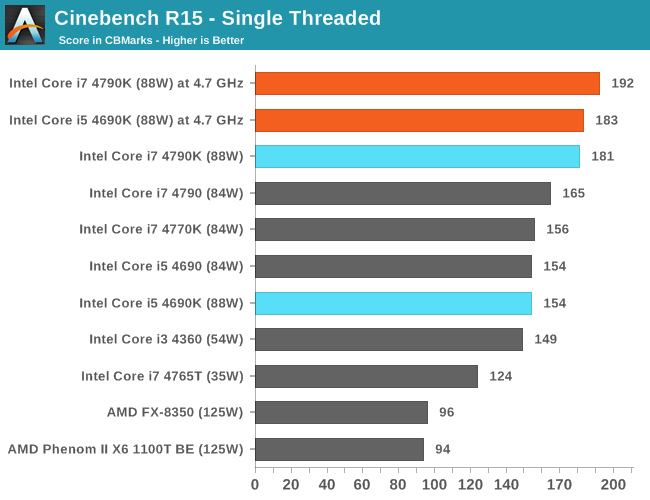

3D Particle Movement
3DPM is a self-penned benchmark, taking basic 3D movement algorithms used in Brownian Motion simulations and testing them for speed. High floating point performance, MHz and IPC wins in the single thread version, whereas the multithread version has to handle the threads and loves more cores.
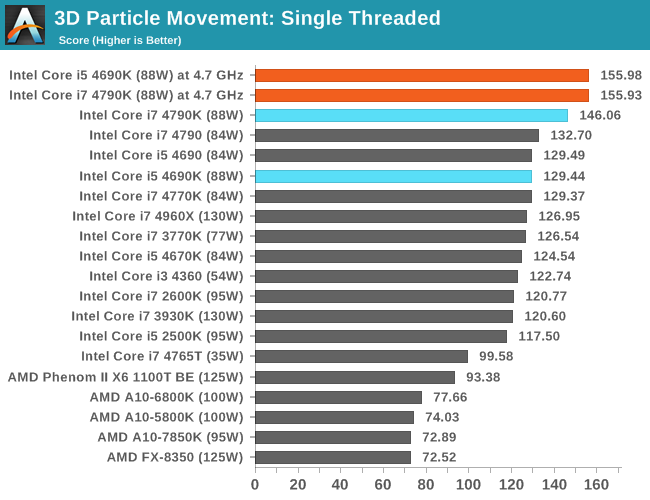
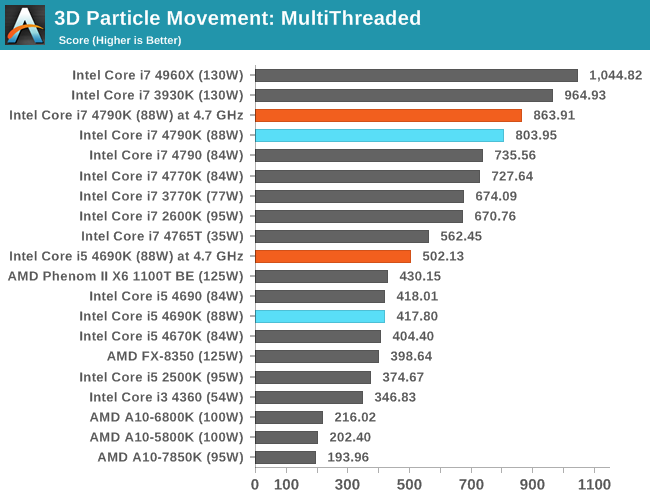
FastStone Image Viewer 4.9
FastStone is the program I use to perform quick or bulk actions on images, such as resizing, adjusting for color and cropping. In our test we take a series of 170 images in various sizes and formats and convert them all into 640x480 .gif files, maintaining the aspect ratio. FastStone does not use multithreading for this test, and results are given in seconds.
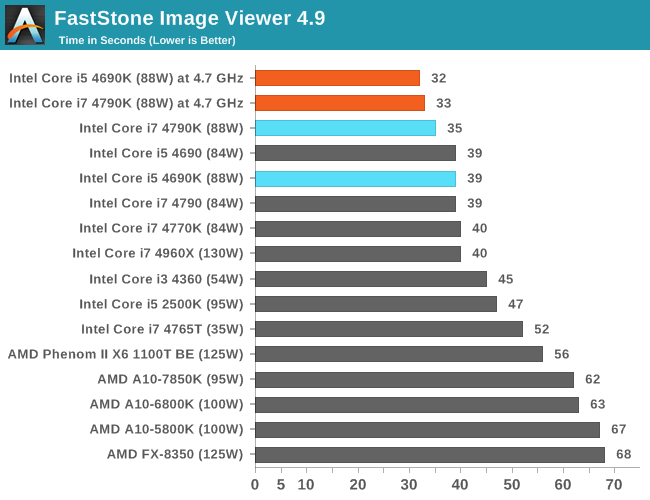
All of our CPU benchmarks are responsive to more frequency, and for tests that are all about single threaded performance (3DPM-ST, FastStone, Dolphin), the overclocked processors match each other. The highly clocked i7-4790K at stock is taking the lead in each of these benchmarks against the other processors at stock frequencies quite easily. For multi-threaded scenarios, it is interesting to note that when overclocked, Handbrake does not seem to use the extra threads that efficiently when encoding 4K60. This is presumably because each thread needs a fair amount of cache and there is little speed-up in switching the work between threads.










117 Comments
View All Comments
leoblaze9 - Friday, July 11, 2014 - link
WOW! what happened in the particle simulation test? that difference is STAGGERING!!just one of the prime examples of the benefits of using both cpu and gpu together as a cohesive whole rather than two discrete entities. I am genuinely amazed at AMD's engineering! kudos AMD....you deserved that one!
MamiyaOtaru - Saturday, July 12, 2014 - link
possible reason they don't use solder anymore: http://iweb.tms.org/PbF/JOM-0606-67.pdfspecifically:
"At higher thermal cycles the cracks have propagated across the entire center region of the die and significantly degrade thermal performance.This failure mechanism is predominant on small die form factors. The center degradation mode is not observed, as the die size is increased to the large and medium sizes"
Smaller die sizes are more likely to see cracks in the solder spread to the middle, significantly harming thermal performance. Ivy Bridge / Haswell with their process shrink have smaller die sizes, perhaps making solder unworkable as a TIM
ZeDestructor - Monday, July 14, 2014 - link
Interesting....Galatian - Saturday, July 12, 2014 - link
I agree: 4,6 GHz seems to be the sweet spot. Mine uses 1,25V core and a 0,175 V offset uncore to reach Ringbus parity. I needed 1,294V for 4,7 and 1,345 for 4,8. Temperatures were off the hook though and this is with a custom-liquid loop with 2 480mm radiators (one monsta and one 25mm) as well as Liquid Ultra. Stability tested with Prime95 24h and IBT 20 runs on maximum (kudos to IDK in the forum for is stability guide).It is an improvement as it seems to be easier to get a rock stable CPU, but temperatures still are a problem. The thing is: I don't believe a better solution would ultimately change anything. I mean when you clearly see that the sweet spot is 4,6 GHz with 1,25V one would assume that 5 GHz probably needs something like 1,5V and that's just dangerously high IMHO.
Also what I realized is that DC needs a lot less Input Voltage. Stock was at 1,8V, but even with my overclock I could dial it all the way down to 1,5V, which is amazing. Ian have you checked how low you can go? (I can't believe I just said that...). Also how exactly can Prime95 ruin a CPU? I still consider it gold standard, as it would show problems within minutes when other stress tests would happily run for hours. I know it is a hassle to let it run for 24h but nothing gets close to rock stable setting then Prime95.
pierrot - Saturday, July 12, 2014 - link
Now we just need the OC'd Anniversary Pentium benchmarks added in!andrew-1983 - Saturday, July 12, 2014 - link
The image is blurry, but the batch number of the 4790k lookslike L336... which if I'm decoding it right means 2013 36th week,
around 2013 September. Does that matter that you are testing
a 10 month old CPU for overclocking?
Galatian - Saturday, July 12, 2014 - link
That number stand for the time the silicon was started to be manufactures or something alike...(read the forums...it has been mentioned several times now)...there are a lot more step until a final chip is put together, so it really is not a 10 month old processor.andrew-1983 - Sunday, July 13, 2014 - link
Ok I get that, but when the retail cpu we buy has an L418C164 that's stillan 8-month difference, whatever the numbers actually mean, and there is
a new microarchitecture or die shrink in every year..
What I'm trying to say is overclockability should be tested with
silicon similar to what people will buy after reading the review.
bludragon - Saturday, July 12, 2014 - link
My chip need 1.237v to be prime95 stable at 4x4.4GHz. This is the stock vid for aturbo on 1 or 2 cores. Using an NH-D14 it would throttle on cores 2 and 3 (so hitting 105+deg?) withing a few minutes. Delidded it maxes at 91 degrees, so at least 15 degrees better and I used the Noctua TIM. I tried 4.6 but the voltage nneds to be 1.27 or higher as it throttled again there.ratbert1 - Saturday, July 12, 2014 - link
With an i5-2500k I still do not see the need to upgrade. I have run at 4Ghz with speedstep and voltage on auto for 3 years. My synthetics will be slower, but using an SSD my everyday usage is fine. Just ran Bioshock Infinite benchmark and got 115 fps average and 41 fps min. @1080p on GTX770 running stock speed(card is OC'd version though). Hopefully Broadwell early next year.